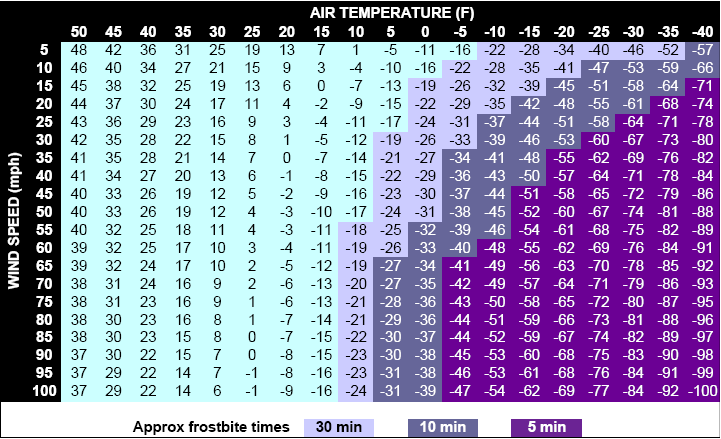

Researchers also studied the thermal properties of actual human faces to determine the value of a key constant in the equation.Wind Chill is a mysterious and often misunderstood phenomenon.

Importantly, the formula reduces the anemometer-based wind speed, measured 33 feet above ground in standard weather observations, to a lower wind speed typically found at the level of a human face (about 5 feet). in November 2001, uses a more sophisticated set of assumptions. The wind chill temperature is never higher than the air temperature, and the windchill is undefined at higher temperatures (above 10 C). As a child, I would check the weather during the winter months to see if the wind chill would result in a day off school. and Canadian scientists organized an effort to revamp the wind chill formula. It turns out that basing the wind chill on a limited set of measurements involving a water bottle was a well-intentioned but less-than-perfect way of estimating the wind’s effect on the human body. This calculates wind chill by measuring how. In fact, at 30 degrees and a 200-mph wind, the old wind chill would have been 50 degrees – totally counterintuitive! New Formula: Tested on Real People In the UK, a system called the Joint Action Group for Temp Indices is used to realistically measure wind chill. But as wind speeds increased beyond the range we normally experience, the mathematical properties of the old formula caused wind chills to reverse and warm up. The early formulas used by the military yielded seriously overblown results for example, a temperature of 30✯ and a wind of 25 mph yielded a wind-chill temperature of 40 below zero – obviously unrealistic.Įven the modified version of that wind chill formula still exaggerated the chilling effect of the wind, at least within the range of everyday wind speeds. If you’re Canadian, you may remember when Canada’s wind chill was given in “watts per square metre per hour” instead of a temperature in degrees same concept.Įventually, in the 1960s and 1970s, formulas were developed to express wind chill as an equivalent temperature, to give people an idea of what kind of calm-air temperature would feel the same as a given temperature-wind combination. Fortunately, you’ll find online calculators. Bright sunshine tends to elevate the apparent temperature. After performing the calculation, make an adjustment for sunshine. Here is the standard formula that was adopted in 2001 by Canada, UK, and the US to compute and analyze the Wind Chill Index: T wc (WCI) 13.12 + 0.6215T a 11.37v +0.16 + 0.3965T a v +0.

If you like math, here’s what you need to calculate: Wind chill 35.74 + (0.6215 × T) (35.75 × Wind sfc 0.16 ) + (0.4275 × T × Wind sfc 0.16 ) Wind sfc equals the wind speed and T, the temperature. If you use mph and F, the formula is Wind chill temperature 35.74 + 0.6215T 35.75V0.16 + 0.4275TV0.16. From those observations, they calculated the rate of heat loss per unit surface area. The National Weather Service actually has a scientific formula for determining what it is. Siple and Passel’s experiment was quite simple: From a post on the roof of the expedition building, they hung a small plastic bottle containing water and measured how long it took to freeze. The original wind chill formula was developed by Paul Siple and Charles Passel as part of an Antarctic expedition from 1939 to 1941. Wind speeds of less than 5 MPH statute have virtually no wind chill factor on the old formula and less than 3 MPH. The real reason you don’t get those 60- and 70-below wind chills you may have had in your younger years is because the formula changed. But as we’re noticing now, sometimes extremely cold and windy weather still happens. True, it’s getting harder to achieve extremely low temperatures nowadays against the backdrop of a warming climate. It’s not global warming – well, mostly not global warming. Does it seem like wind chills aren’t what they used to be when you grew up? There’s a reason.


 0 kommentar(er)
0 kommentar(er)
